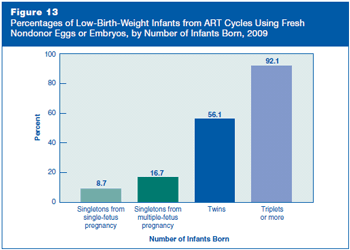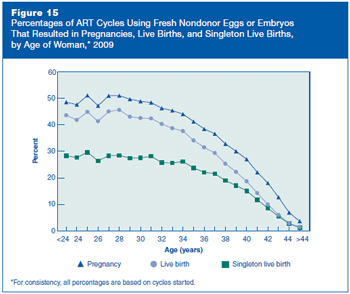Section 2: ART Cycles Using Fresh, Nondonor Eggs or Embryos (Part A)
Click on titles or images to go back to Section 2 Part A.
Figure 6 is a bar graph representing outcomes of ART cycles using fresh nondonor eggs or embryos, by stage, 2009.
- 102,478 cycles started
- 91,182 retrievals
- 84,039 transfers
- 37,780 pregnancies
- 30,787 live-birth deliveries
Figure 7 is a pie chart representing reasons ART cycles using fresh nondonor eggs or embryos were discontinued in 2009. Note: The statistics are based on 11,296 ART cycles.
- No or inadequate egg production 82.9%
- Patient withdrew for other reasons 12.1%
- Too-high response to ovarian stimulation medication 4.2%
- Concurrent illness 0.8%
- Unknown <0.1%
Figure 8 is a bar graph representing measures of success for ART cycles using fresh nondonor eggs or embryos, 2009.
- Cycles resulting in pregnancies 36.9%
- Cycles resulting in live births 30.0%
- Retrievals resulting in live births 33.8%
- Transfers resulting in live births 36.6%
- Cycles resulting in singleton live births 23.5%
- Transfers resulting in singleton live births 25.5%
Figure 9 is a pie chart representing results of ART cycles using fresh nondonor eggs or embryos, 2009.
- No pregnancy 62.5%
- Ectopic pregnancy 0.6%
- Clinical pregnancy 36.9%, which is subdivided as follows:
- Single-fetus pregnancy 22.8%
- Multiple-fetus pregnancy 11.6%
- Not able to determine the number of fetuses 2.5%
Figure 10: Outcomes of Pregnancies Resulting from ART Cycles Using Fresh Nondonor Eggs or Embryos, 2009.
Figure 10 is a pie chart representing outcomes of pregnancies resulting from ART cycles using fresh nondonor eggs or embryos, 2009. Note: Total does not equal 100% due to rounding. Maternal deaths prior to birth are not displayed due to small number of cycles (n = 7).
- Miscarriage 16.4%
- Induced abortion 0.9%
- Stillbirth 0.7%
- Total live births 81.5%, which is subdivided as follows:
- Singleton birth 56.6%
- Multiple-infant birth 24.9%
- Unknown outcome 0.4%
Figure 11: Risks of Having Multiple-Fetus Pregnancies and Multiple-Infant Live Births from ART Cycles Using Fresh Nondonor Eggs or Embryos, 2009.
Figure 11 depicts two pie charts, A and B, representing risks of having multiple-fetus pregnancies and risks of having multiple-infant live births from ART cycles using fresh nondonor eggs or embryos, 2009.
- Pie chart A represents 37,780 pregnancies.
- Singletons 61.7%
- Total multiple-fetus pregnancies 31.6%, which is subdivided as follows:
- Twins 28.5%
- Triplets or more 3.1%
- Not able to determine the number of fetuses 6.7%
- Singletons 69.5%
- Total multiple-infant live births 30.5%, which is subdivided as follows:
- Twins 28.9%
- Triplets or more 1.6%
Figure 12: Percentages of Preterm Births from ART Cycles Using
Fresh Nondonor Eggs or Embryos, by Number of Infants Born, 2009.
Figure 12 is a bar graph representing percentages of preterm births from ART cycles using fresh nondonor eggs or embryos, by number of infants born, 2009.
- 11.6% preterm births of singletons from single-fetus pregnancy
- 19.0% preterm births of singletons from multiple-fetus pregnancy
- 60.0% preterm births of twins
- 97.5% preterm births of triplets or more
Figure 13: Percentages of Low-Birth-Weight Infants from ART Cycles Using Fresh Nondonor Eggs or Embryos, by Number of Infants Born, 2009.
Figure 13 is a bar graph representing percentages of low-birth-weight infants from ART cycles using fresh nondonor eggs or embryos, by number of infants born, 2009.
- 8.7% low birth weight infants, singletons from single-fetus pregnancy
- 16.7% low birth weight infants, singletons from multiple-fetus pregnancy
- 56.1% low birth weight infants, twins
- 92.1% low birth weight infants, triplets or more
Figure 14 is a line graph representing the age distribution of women who had ART cycles using fresh nondonor eggs or embryos, 2009.
- Age <24, 0.5%
- Age 24, 0.5%
- Age 25, 0.9%
- Age 26, 1.3%
- Age 27, 2.0%
- Age 28, 3.0%
- Age 29, 3.8%
- Age 30, 4.7%
- Age 31, 5.4%
- Age 32, 6.0%
- Age 33, 6.3%
- Age 34, 6.9%
- Age 35, 6.9%
- Age 36, 7.0%
- Age 37, 7.3%
- Age 38, 7.5%
- Age 39, 7.5%
- Age 40, 6.6%
- Age 41, 5.4%
- Age 42, 4.3%
- Age 43, 3.0%
- Age 44, 1.7%
- Age 45, 0.8%
- Age 46, 0.3%
- Age 47, 0.1%
- Age 48, 0.1%
- Age >48, <0.1%
Figure 15: Percentages of ART Cycles Using Fresh Nondonor Eggs or Embryos That Resulted in Pregnancies, Live Births, and Singleton Live Births, by Age of Woman, 2009.
Figure 15 is a line graph with three lines representing percentages of ART cycles using fresh nondonor eggs or embryos that resulted in pregnancies, live births, and singleton live births, by age of woman, 2009. Note: For consistency, all percentages are based on cycles started.
- Age <24, Pregnancy 48.5%, Live birth 43.6%, Singleton live birth 28.4%
- Age 24, Pregnancy 47.6%, Live birth 41.8%, Singleton live birth 27.6%
- Age 25, Pregnancy 51.1%, Live birth 44.9%, Singleton live birth 29.7%
- Age 26, Pregnancy 47.2%, Live birth 41.4%, Singleton live birth 26.4%
- Age 27, Pregnancy 50.9%, Live birth 45.0%, Singleton live birth 28.4%
- Age 28, Pregnancy 51.0%, Live birth 45.6%, Singleton live birth 28.5%
- Age 29, Pregnancy 49.7%, Live birth 43.1%, Singleton live birth 27.4%
- Age 30, Pregnancy 48.9%, Live birth 42.6%, Singleton live birth 27.5%
- Age 31, Pregnancy 48.4%, Live birth 42.4%, Singleton live birth 28.1%
- Age 32, Pregnancy 46.3%, Live birth 40.3%, Singleton live birth 25.8%
- Age 33, Pregnancy 45.4%, Live birth 38.7%, Singleton live birth 25.6%
- Age 34, Pregnancy 44.0%, Live birth 37.7%, Singleton live birth 26.2%
- Age 35, Pregnancy 41.2%, Live birth 34.1%, Singleton live birth 23.7%
- Age 36, Pregnancy 38.5%, Live birth 31.5%, Singleton live birth 22.1%
- Age 37, Pregnancy 36.6%, Live birth 29.4%, Singleton live birth 21.6%
- Age 38, Pregnancy 32.8%, Live birth 25.3%, Singleton live birth 19.0%
- Age 39, Pregnancy 30.0%, Live birth 22.3%, Singleton live birth 17.2%
- Age 40, Pregnancy 27.0%, Live birth 18.7%, Singleton live birth 15.1%
- Age 41, Pregnancy 22.1%, Live birth 14.3%, Singleton live birth 11.8%
- Age 42, Pregnancy 18.1%, Live birth 10.0%, Singleton live birth 8.6%
- Age 43, Pregnancy 12.7%, Live birth 6.0%, Singleton live birth 5.5%
- Age 44, Pregnancy 6.9%, Live birth 2.9%, Singleton live birth 2.8%
- Age >44, Pregnancy 3.7%, Live birth 1.5%, Singleton live birth 1.2%
Contact Us:
- Centers for Disease Control and Prevention
1600 Clifton Rd
Atlanta, GA 30333 - 800-CDC-INFO
(800-232-4636)
TTY: (888) 232-6348 - New Hours of Operation
8am-8pm ET/Monday-Friday
Closed Holidays - cdcinfo@cdc.gov












